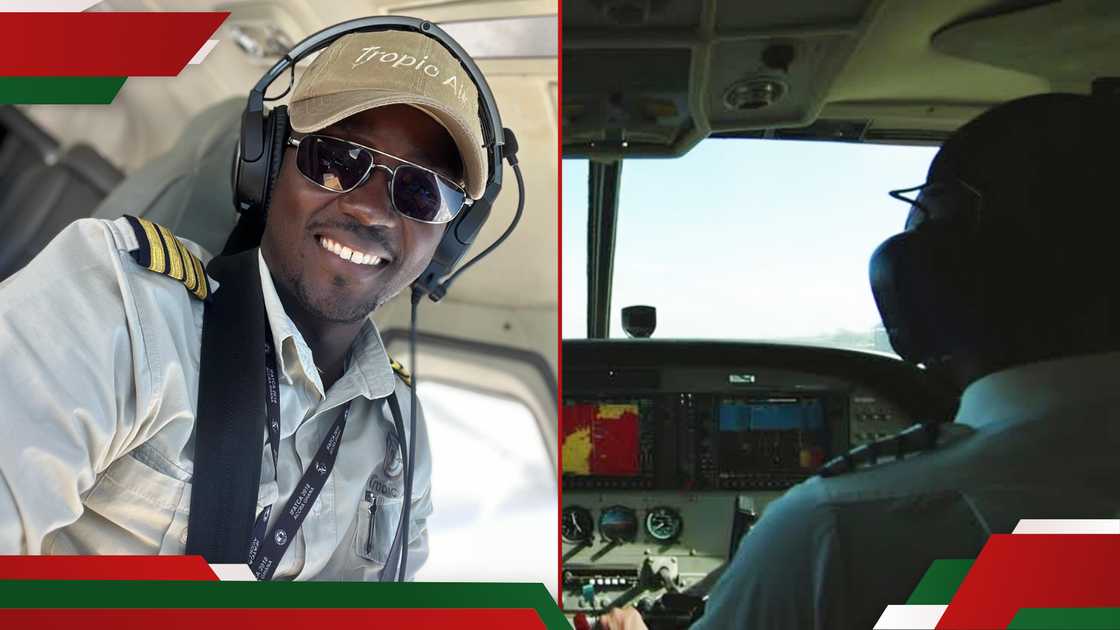- For many, becoming a commercial pilot is a childhood aspiration that often vanishes in adulthood.
- It's never too late to re-experience the dream through other means, such as your children or younger siblings.
- Due to this reason, Ian Njeru Njiraini, a licensed Kenyan pilot, has outlined the crucial steps, expenses, and prerequisites necessary to become a commercial pilot.
Becoming a commercial pilot involves a highly structured and demanding process that necessitates academic qualifications, flight training, and a series of certifications.

Ian Njeru Njiraini, a licensed Kenyan pilot, has outlined the key steps and requirements for those seeking to join the aviation sector.
1. Academic Requirements
To be admitted to an aviation school in Kenya, an applicant must have a minimum KCSE grade of C+ in Mathematics, English, Physics, and Geography, and an overall grade of C+.
These subjects equip aspiring pilots with the essential analytical and problem-solving skills.
2. Medical Fitness Assessment
Before beginning flight training, candidates must undergo a medical examination by a certified aviation medical examiner.
The test evaluates the candidate's physical and mental aptitude to fly. The medical report outlines any health limitations that could impact flying capability.
Student Pilot's License
After being medically cleared, the next step is to enroll in an aviation school.
He added that trainees start by flying small planes, like the Cessna 172, under a Student Pilot's License.
The minimum age requirement to obtain a Specialized Pilot License (SPL) is 16 years, and the cost of training is approximately $235 per hour.
The Private Pilot's License (PPL) is a license that permits you to fly a private aircraft for personal use. To obtain a PPL, you must meet certain requirements and pass a series of exams. The license is typically issued by a civil aviation authority.
After accumulating a minimum of 40 hours of flight time, trainees become eligible to apply for a Private Pilot's License (PPL).
The minimum age requirement is 17 years, and the training costs approximately $650 per hour.
Ian emphasized that the PPL permits pilots to fly solo, but not for financial gain.
5. Commercial Pilot's License (CPL):
To become a qualified commercial pilot, a trainee must undergo comprehensive ground training and accumulate a total of 200 flight hours.
The minimum age for earning a Commercial Pilot's License (CPL) is 18 years. This license enables pilots to be compensated for their flying services.
6. Multi-Engine Rating (MER)
To boost their career opportunities, many pilots obtain a Multi-Engine Rating (MER).
This requires an additional 20 hours of flight simulation and 20 hours of actual flight in a multi-engine aircraft.
"At this stage, a pilot is fully certified and qualified to apply for positions in commercial airlines, including the national airline, Kenya Airways," he added.
Throughout their careers, pilots must keep a precise logbook to record flight hours, which is essential for advancing to senior roles such as captain.
Pursuing a career as a commercial pilot is a challenging yet highly rewarding profession, providing exciting career paths within the aviation sector.
Ian says that pilots live relatively uncomplicated lives.
In a previous article, Ian clarified the misconception that pilots lead a glamorous lifestyle and are involved in multiple relationships.
He stated that while some pilots do get to live a life of luxury, driving high-end cars and indulging in worldly pleasures, the majority are actually quite humble.
Ian asserted that the majority of pilots live a straightforward lifestyle, are deeply devoted to their faith, are committed to their spouses, are born-again Christians, and abstain from alcohol.
